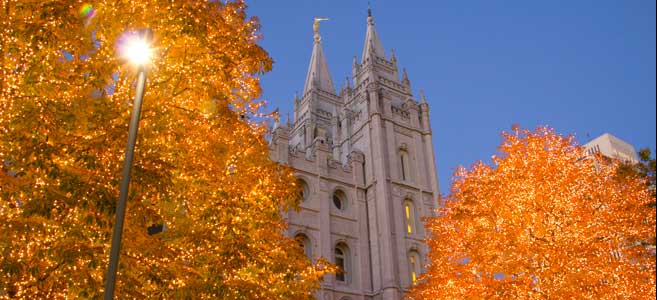Lighting Up Temple Square

Article Highlights
- The Lights on Temple Square display will be held November 26, 2010, through January 1, 2011.
- Preparations for the display begin in August. Take down isn’t finished until March.
- All of the work is done with one main goal in mind: to testify of the Light of the World.
“We do this to share the most important message in the world: the birth of Christ.” —Eldon Cannon, Grounds Services group manager
By early August, cables and extension cords are winding up the trunks of many of the trees on Temple Square. As the weeks hurry past, strands of tiny LED lights seem to grow from even the smallest tree branches. November brings the greatest changes with a rush of workers, missionaries, and volunteers setting up garlands, luminarias, lanterns, and nativities. When Thanksgiving is over, Temple Square will be ready to bring a unique and special spirit to the Christmas season.
Eldon Cannon, the Grounds Services group manager, and Jennifer Udy, a gardener, took a few minutes from their hectic schedules in early November to talk about the work that goes into putting the Christmas lights up.
Everything on the grounds has to be done by the week of Thanksgiving in order to be ready for the first night of lights on November 26. As many as 100 people might be on the grounds at a given time, hanging garlands or straightening luminarias. Families and Church groups spend an evening draping nets of lights over shrubs, while service missionaries hang garlands that function as cordons along the sidewalks.
Workers “plant” young trees, already strung with lights, that have been harvested from State Educational Trust Fund lands. Using these trees has multiple benefits, for Temple Square and for the state. For the state, the money used to purchase the trees benefits the state educational system, and thinning state-owned stands of timber allows the remaining trees to grow strong and healthy, producing better lumber. For Temple Square, using stand-in trees for the lights display protects the living trees.
Wrapping lights on a living tree causes stress to the tree. The wrapping process breaks branchlets, while the heat from the artificial lights can help tree diseases and bugs overwinter. The heat also does harm because of the sudden temperature change when the lights are turned on or off. Going from warm to cold repeatedly and abruptly causes the tree’s cell structures to tear. For these reasons, the Cedar of Lebanon is lit only every other year and stand-in trees are used to supplement the number of living trees that are lit.
But these concerns aren’t what Eldon or Jennifer consider most difficult. Eldon considers cold weather the greatest obstacle to the months-long decorating process, because the temperature is hard on the people working outside. Jennifer thinks that beginning to decorate in August is the hardest part. The work is “fun for a little while,” but quickly gets wearing after spending two weeks at a time wrapping one set of trees.
Jennifer smiles as she explains that this is part of the reason that her favorite part, outside of the end result, is when things start coming together in November. The work moves faster and the end is near, and that makes the work fun again.
Eldon confesses that he likes to eavesdrop on the visitors that come to enjoy the holiday display. Because no one knows who he is, they are completely honest about what they think of the display. Eldon especially enjoys the excited reactions of the children who visit.
As much as he wants people to have a good time, Eldon wants even more for people to understand why the lights are displayed each year. “We do this to share the most important message in the world: the birth of Christ. He is our Savior. He sacrificed for us.”
Jennifer nods, explaining that people often ask why the particular color schemes are chosen instead of more Christmas-y themes. The theme of the lights is such that they are “in harmony with each other and with the Temple Square spirit,” she says, rather than based on traditional holiday color schemes. The colors are meant to encourage the true spirit of the season and to remind people of the Savior.
The nativities from around the world bear testimony of the Savior's birth. The glowing luminarias offer messages of peace, joy, and hope. And the lights invite visitors to remember the Light of the World.
The flurry of set up activity will subside after Thanksgiving. A night crew will turn the lights on and off in the evenings, walk the grounds to be sure all is well, and perform any maintenance that is needed. When the season ends on January 1, 2011, the lights will go out, but the grounds crew hopes that the memories of visitors' spiritual experiences will continue to burn brightly.

